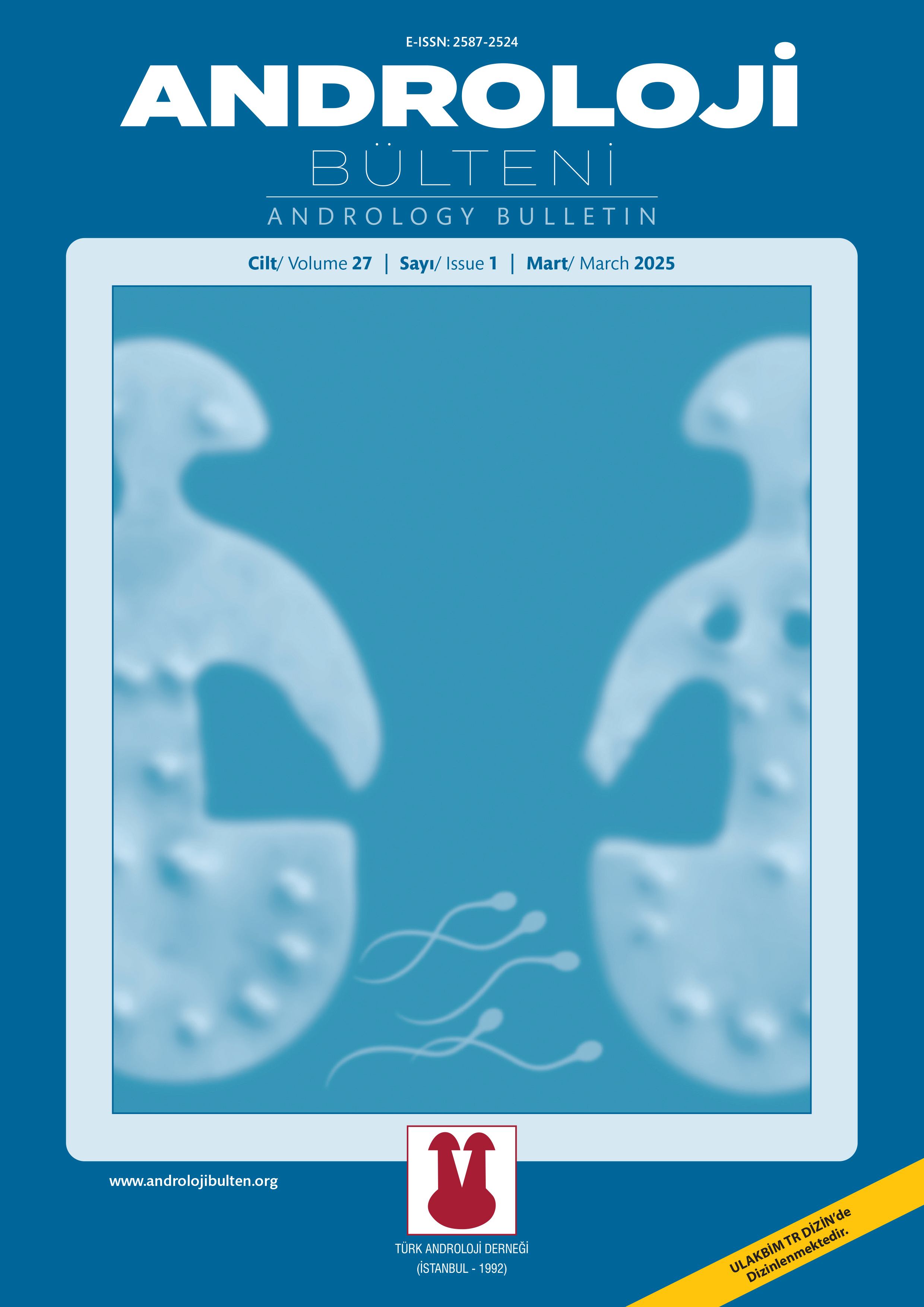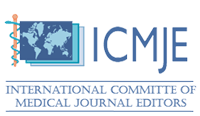INDEXES

Content of this journal is licensed under a Creative Commons Attribution-NonCommercial 4.0 International License.
Volume: 25 Issue: 2 - 2023
| 1. | Cover Page I |
| 2. | Reviewers Pages II - III |
| 3. | From the President Page IV |
| 4. | From the Editor Page V |
| 5. | Contents Page VI |
| ORIGINAL ARTICLE | |
| 6. | Do topical steroid creams have efficiency on the treatment of phimosis evolving after circumcision implemented with thermocautery? Kenan Yalçın doi: 10.24898/tandro.2023.63496 Pages 67 - 72 OBJECTIVE: Thermocautery device is commonly used in circumcisions implemented under local an anaesthesia for a quick and safe circumcision. One of the complications that might evolve after circumcision implemented with thermocautery is pathological phimosis. Treatment of this complication is generally surgical revision. There are very few studies in the literature about it’s medical treatment. In this study, we aimed to search the efficiency of topical corticosteroid application in the the treatment of pathological phimosis evolving after circumcision implemented with thermocautery. MATRERIAL and METHODS: Datas of 54 patients aged 1–9 who evolved pathological phimosis complication after circumcision in our hospital between 2011–2021 were examined retrospectively. Efficiency of topical corticosteroid application in the treatment of pathological phimosis evolving after circumcision implemented with thermocautery was evaluated. RESULTS: In 38 cases which grade 5 phimosis evolved after surgery there was no response to steroid treatment. In 6 of the 8 patients who evolved grade 4 phimosis there was no response to steroid treatment. Although there was partial response and regression to grade 3 in two patients, full recovery was not achieved and grade 4 phimosis reevolved in 2–3 weeks. 0.05% clobetasol propionate a highly strong steroid (Dermovate 0.05% 50 gr, Turkey) for 6–8 weeks morning and evening was implemented to all of the patients and circumcision revision was made in all 46 patients with no response. In 8 cases patient’s relatives did not accept topical corticosteroid and circumcision revision was made. CONCLUSION: As a result, topical steroid is not found to be effective in the treatment of phimosis evolving after circumcision implemented with thermocautery. |
| 7. | Evaluation of the quality and reliability of YouTube videos on microscopic varicocelectomy İsmail Emre Ergin, Abuzer Öztürk, Arslan Fatih Velibeyoğlu, Aydemir Asdemir, Hüseyin Saygın, Esat Korgalı doi: 10.24898/tandro.2023.60487 Pages 73 - 77 OBJECTIVE: In this study, our aim is to evaluate the quality and reliability of Turkish videos associated with Microscopic Varicocelectomy on YouTube. MATRERIAL and METHODS: YouTube’s search function was used to find videos associated with Microscopic Varicocelectomy. On January 1, 2023, systematic research was performed using the term “Microscopic Varicocelectomy”, covering the last 5 years in order to be up to date. The first 50 videos were included in the study. The quality of the videos was evaluated using the Global Quality Score (GQS). The modified DISCERN scale was used to evaluate the reliability of the videos. RESULTS: A total of 50 videos associated with microscopic varicocelectomy were analyzed. 64% videos were repaired by a urologist who deals with infertility. 56% of the medical doctors had academic titles. The most frequently discussed topics in the videos were comparison with other methods (54%), factors that increase the success of the microscopic varicocelectomy procedure (52%), success rates of the microscopic varicocelectomy procedure (30%), postoperative complications (22%) and operation time (%20). The mean GQS of the videos was 2,86±1,17. When the reliability of the sources was evaluated using the DISCERN score, the mean score of the videos was 2,57±0,84. There were no fullrated videos from DISCERN. CONCLUSION: The present study shows that the level of knowledge in Turkish sources on YouTube associated with micro TESE is at an acceptable level, but its scientific reliability is low. Therefore, short and concise videos that contain accurate and up-to-date information and refer to scientific facts in plain language should be prepared by the relevant associations. |
| 8. | Prediction of the effect of inflammatory markers such as neutrophil/lymphocyte ratio (NLR), platelet/lymphocyte ratio (PLR), monocyte/eosinophil ratio (MER) on changes in spermiogram parameters after varicocele surgery Murat Beyatlı, Feyza Beyatlı, Mehmet Duvarcı, Aykut Demirci, Fatih Hızlı, Halil Basar doi: 10.24898/tandro.2023.26937 Pages 78 - 86 OBJECTIVE: In this study, we aimed to predict the changes in postoperative spermiogram parameters in patients who underwent varicocelectomy by using pre- and post-operative hemogram parameters and inflammatory blood markers. MATRERIAL and METHODS: 25 patients who underwent microscopic varicocelectomy in our clinic and met the study criteria were included in the study. Hemogram parameters were measured just before and twenty (20) days after the surgery, and spermiogram parameters were measured 6 months after the surgery. The patients seperated into two groups. Patients with >50% improvement in postoperative Total Motile Sperm Count (TMS) were included in the recovered patients group, and patients with less than 50% improvement were included in the non-recovered patients group. Neutrophil / lymphocyte ratio (NLR), platelet / lymphocyte ratio (PLR), monocyte / eosinophil ratio (MER), and blood counts such as neutrophil, lymphocyte, platelet, monocyte, eosinophil were compared in groups, also were compared before and after surgery, separate RESULTS: Improvement in TMS was observed in patients with a statistically significant decrease in postoperative NLR (p = 0.009; p <0.01). As a result of the calculations, cut-off point for the NLR change was accepted as 1.06% and above. PLR and MER parameters were not statistically significant in predicting the improvement of TMS. Among the neutrophil, lymphocyte, platelet, monocyte, eosinophil counts, preoperative neutrophil and preoperative monocyte counts were found to be higher in patients with postoperative TMS improvement. Cut-off points for these preoperative neutrophil and monocyte counts were calculated as 3.77 and 0.47, respectively. In our study, we could not reach any statistically significant result for lymphocyte, eosinophil and platelet counts. CONCLUSION: Preoperative and postoperative results of NLR, neutrophil or monocyte counts can be used as a marker to predict improvement in TMS. |
| 9. | Does Covid-19 affect sperm parameters? Hüseyin Saygın, İsmail Emre Ergin doi: 10.24898/tandro.2023.47135 Pages 87 - 91 OBJECTIVE: The effect of Covid-19 on the male urogenital system is still under investigation. As with many medical issues, male sexual and reproductive health is an important public health problem to be addressed in the Covid-19 pandemic. MATRERIAL and METHODS: The patients who applied to our outpatient clinic with the diagnosis of primary infertility before the Covid-19 pandemic were investigated. Those who had a positive PCR result and had the disease symptomatically were included in the study. After infection, sperm analyzes were requested. Sperm analyzes were evaluated according to 2010 WHO data and compared with pre-disease results. RESULTS: The average ejaculate volume in the spermiograms of the patients before Covid infection was: 2.96±0.84 ml, the mean sperm count was: 48.92±34.9 million, the average sperm count in ml was: 16.52+5.71 million, the number of motile sperm was: 55.7% ±16.3% fast forward sperm count was: 38.0% ±18.3%, normal morphology sperm count was: 4.0% ±0.76%. The average time from the Covid PCR test positivity to the second spermiogram date was 2.6±0.9 (1– 4) months. The average ejaculate volume in the spermiograms of the patients after Covid infection was: 2.83±0.92 ml, the average sperm count was: 58.5±32.3 million, the average sperm count per ml was: 20.6±6.86 million, motile sperm count was 54.8% ±17.4%, fast forward sperm count was: 45.3% ±20.7%, sperm count in normal morphology was: 4.7% ±0.43%. CONCLUSION: In our study, no significant difference was found in sperm parameters. The lack of variation in sperm parameters was believed to be due to the completion of the inflammatory phase. |
| 10. | Results of circumcision made with the partly modified guillotine technique by a single urologist Aydemir Asdemir, Abuzer Öztürk doi: 10.24898/tandro.2023.14892 Pages 92 - 95 OBJECTIVE: Circumcision which has a history nearly same with the history of humanity has been being applied in many different techniques over the centuries. Over the times, by the increasing developments in science especially medicine, the circumcision applied in operating room and in appropriate sterilization conditions is one of the oldest known surgical procedures. In this retrospective study, we aimed to discuss the results of the modified guillotine method. MATRERIAL and METHODS: Between December 2015 and July 2021, 1295 cases who were circumcised using modified guillotine technique were reviewed retrospectively. Their mean age, duration of surgery and surgical intervention results were evaluated. RESULTS: The mean age of the patients was 4.48±2.7. The mean procedure time was calculated as 15.9±3.3 minutes. In 7 (0%.54) patients complications due to anesthesia, in 25 (1%.93) patients complications due to surgical intervention were observed. Mortal or morbid complications were not observed. CONCLUSION: The modified guillotine method with low complication rates in children who underwent circumcision is a successful surgical procedure which can be used in a second step peripheral district governmental hospital. |
| REVIEW | |
| 11. | Legal status and ethical issues in assisted reproductive techniques Hilal Gül Boyraz, Hatice Nur Nefes, Ebru Aydın, Nülüfer Erbil doi: 10.24898/tandro.2023.46656 Pages 96 - 102 Infertility is a psychologically threatening, stressful, painful and economic problem for couples and can become a social problem that can affect the family and society. Infertility can develop as primary or secondary infertility, cause mental and sexual problems, and affect quality of life. Many pregnancies have occurred in infertile couples with assisted reproductive techniques, which include processing reproductive cells or embryos. With the advancement of technology and medicine, assisted reproductive techniques have been developed. In Turkish law, there is no illegality in assisted reproductive techniques in the case of marriage, and the involvement of a third person or persons in the process is rejected. Since the medical interventions on the basis of the beginning of life and the existence of humanity are sensitive and multidimensional, assisted reproductive techniques also cause many ethical problems. Assisted reproductive techniques are discussed at the national and international level and vary between countries due to scientific and cultural differences. Nurses have responsibilities such as evaluation of infertile couples, implementation of the planned treatment, case management and patient advocacy |
| 12. | Current approach to premature ejaculation Burak Köseoğlu, Özer Üzel, Ali Atan doi: 10.24898/tandro.2023.13334 Pages 103 - 111 Premature ejaculation (PE) is the most common ejaculation disorder affecting all age groups. It is a clinical condition that causes psychological stress and loss of self-confidence in the patient and has a negative effect on quality of life. While the main treatment of primary PE is pharmacotherapy, treatment of the underlying secondary causes may be more important in acquired PE. Behavioral treatments should be used in the initial phase and accompany pharmacological treatments. Pharmacological agents that can be used in the treatment of PE are selective serotonin reuptake inhibitors (SSRI), topical anesthetics, tramadol, tricyclic antidepressants (TCA), phosphodiesterase-5 inhibitors (PDE5i), α-1 blockers and some combinations of these. Invasive interventions are experimental and not recommended by the guidelines. Patient and partner compatibility can be said to be the most important factor that brings success in treatment. |
| 13. | ESWT success in erectile dysfunction and Peyronie’s disease Yılmaz Aslan, Ali Atan doi: 10.24898/tandro.2023.88156 Pages 112 - 118 Treatment of Erectile Dysfunction (ED) should be started with the elimination of correctable factors such as diabetes, cardiovascular causes, and drug use that cause ED, and lifestyle changes. Currently ED treatment mostly depends on phosphodiesterase type 5 inhibitors, which fail for some ED patients. Surgical and nonsurgical treatments in Peyronie’s disease related ED are frequently difficult to achieve satisfactory results. Recent studies indicate that extracorporeal shock wave therapy induces neoangiogenesis and positively affects on penile hemodynamics. In this review the evidence of clinical efficacy of extracorporeal shock wave therapy for the treatment of erectile dysfunction and Peyronie’s disease. |
| 14. | Managing priapism in childhood Berkcan Akkaş, Ahmet Ender Caylan, Murat Uçar doi: 10.24898/tandro.2023.67984 Pages 119 - 126 Priapism is defined as a persistent erection that prolongs for more than 4 to 6 hours regardless of sexual stimulation. It is rare in pediatdrc population and might be frequently due to sickle cell anemia, hematologic disorders, toxins, malignancy and drugs. Ischemic subtype is the most common type in childhood. It is still challenging for clinicians to manage pediatric age patients with priapism in consequence of lack of well established data. In this review, the literature is searched in order to understand and manage properly the clinical classification, etiology, pathology and novel treatment modalities. |
| 15. | Contraception and counseling for women with cardiovascular disease Seda Dorukoğlu, Zeynep Daşıkan doi: 10.24898/tandro.2023.66563 Pages 127 - 134 The risk of maternal and neonatal morbidity and mortality is high in pregnancies of women that they have cardiovascular disease (CVD). Unplanned pregnancies are very risky if health cannot be optimized before conception. Despite the known risks of unplanned pregnancies, 25% to 54% of women with cardiovascular heart disease continue to have unplanned pregnancies. It is important to provide reliable contraception counseling and pregnancy planning before pregnancy to optimize the health of both mother and baby in this population. Early and accurate contraceptive counseling for women of reproductive age with cardiovascular heart disease is must to prevent unplanned pregnancies in this population. The purpose of this review; To define contraceptive method options in women with cardiovascular heart disease, to examine the risks, benefits and contraceptive method medical eligibility criteria within the scope of counseling in line with the literature. |
| PUBLICATIONS AND CONGRESS CALENDAR OF ANDROLOGY | |
| 16. | Publications and Congress Calendar of Andrology Pages 135 - 140 Abstract | |














